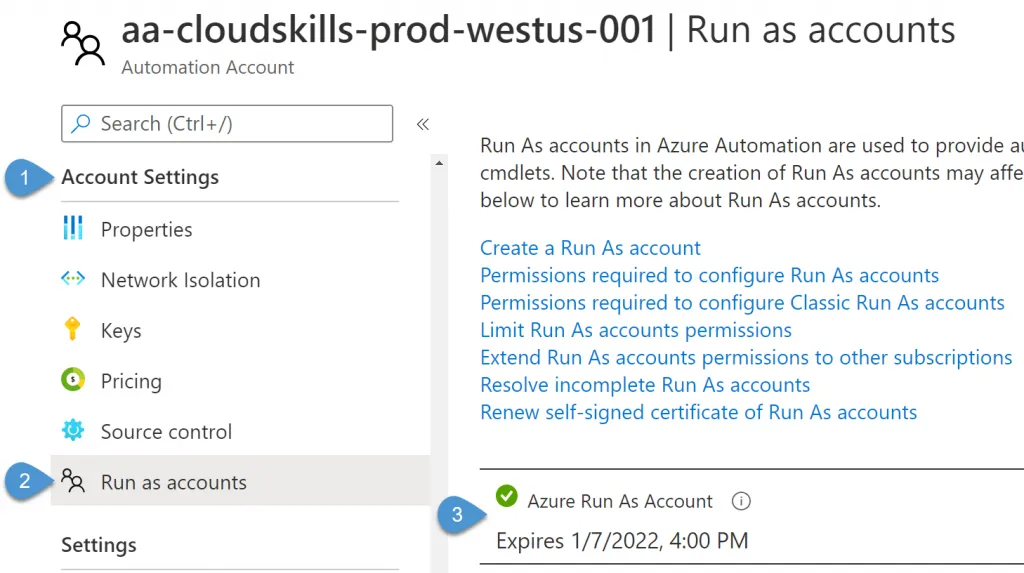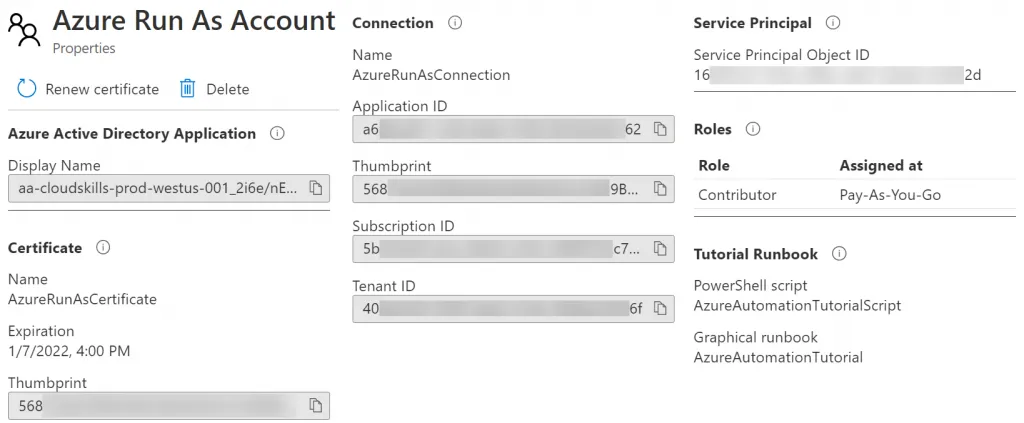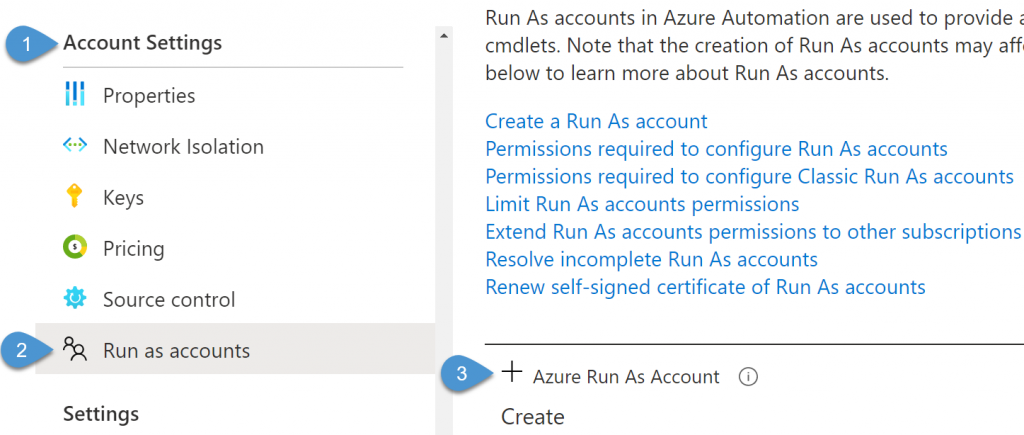In a previous tutorial, you learned about creating your first Azure Automation PowerShell runbook. You set up an Azure Automation account, authored a PowerShell runbook, and incorporated parameters and variable assets. This guide explores the Azure Automation Run As account so your runbooks can access Azure resources. You will also learn how to PowerShell modules to add cmdlets to your runbooks. When you’re finished, you’ll have the skills to elevate your runbooks to the next level.
Microsoft is retiring Run As accounts in favor of managed identities. Learn all about Azure Automation and managed identities.
Azure Automation Managed Identity: Getting Started
Prerequisites
Before you begin this guide, you’ll need the following:
- Azure tenant and subscription
- Administrator account with sufficient permissions on a subscription, such as Owner, or a role containing Microsoft.Automation resource authorization
- PowerShell knowledge
This tutorial was originally posted on the CloudSkills.io blog. Many thanks to Mike Pfeiffer!
Viewing Azure Automation Run As Account
In the first tutorial, you allowed Azure to create an Azure Run As account for your automation account. By enabling this option, Azure will automatically create an Azure AD application. You can use this application identity to authenticate to an Azure subscription to access and manage resources. During the Run As account creation, Azure performs several other functions such as:
- Adding a self-signed certificate to the application account.
- Creating a service principal identity for the application.
- Assigning the Contributor role for the account in the current subscription.
- Creating Automation connection assets named AzureRunAsCertificate and AzureRunAsConnection.
If you want to view more information about the Run As account, from the Automation Account resource page, navigate to Account Settings > Run as accounts.

You can view the account’s properties in the portal, including the certificate thumbprint, the Azure AD application information, service principal ID, role assignments, and runbooks utilizing the account.

At the top of the properties page, note an action named Renew Certificate. The account’s certificate is only valid for one year, so be sure to renew before expiration to keep your runbooks from failing.
Along with the Run As account, Azure will create two connection assets: AzureRunAsCertificate and AzureRunAsConnection. The certificate asset authenticates to Azure so the runbook can manage Azure Resource Manager resources. The connection asset contains the application ID, tenant ID, subscription ID, and certificate thumbprint. Basically, everything you need to connect to Azure to start managing resources! In an upcoming example, you will use this connection to connect to Azure and retrieve some resources.
Importing PowerShell Modules
Before creating a new runbook to manage my Azure resources, make sure you have the correct PowerShell commands available. When you create a new Automation Account, Azure will automatically import some PowerShell modules for you, such as AzureRM.Automation, AzureRM.Computer, and AzureRM.Resources. However, these modules are a part of the older AzureRM PowerShell module, which Microsoft is no longer developing. Microsoft has replaced this module with the newer Az PowerShell module.
Luckily, you’re not stuck using the older modules in my PowerShell runbooks. You can import the new Az modules into the Automation Account for use with your PowerShell code. From the Automation Account, navigate to Shared Resources > Modules gallery. The first module to import is the Az.Accounts module to use the Connect-AzAccount cmdlet in my runbook. Search for “Az.Accounts”, then select the resulting module.

Search for the cmdlets and functions from the module page to verify cmdlet availability. From here, select the Import action at the top. Once the import is successful, navigate the Modules gallery and perform the same steps for the Az.Resources module to use the Get-AzResourceGroup in your runbook.
The imports can take a few minutes, but you can verify the status by navigating back to Shared Resources > Modules. Verify the module import progress in the Status column.
From this Modules page, note there are options to import a custom module. Select the + Add a module and choose a .zip file that contains the module code. Note that the module code’s file name must match the file name of the zip file. Importing a custom-written module is a fantastic feature of Azure Automation that allows you to write a runbook to fit any scenario.
Connecting to Azure from PowerShell Runbook
Back in the Automation Account, create a new runbook that will connect to Azure and retrieve resource groups. In the Automation Account, navigate to Process Automation > Runbooks, then select + Create a runbook. From here, input a name for the runbook, select the PowerShell runbook type, then select Create.
In the Edit PowerShell Runbook window, write code that will retrieve the information stored in AzureRunAsConnection. For this, use the Get-AutomationConnection cmdlet and specify the name of the Run As connection. If you store the connection information to a variable, you can reference the tenant ID, application ID, and certificate thumbprint in the Connect-AzAccount cmdlet to authenticate to your Azure tenant.
$connection = Get-AutomationConnection -Name AzureRunAsConnection
Connect-AzAccount -ServicePrincipal `
-Tenant $connection.TenantID `
-ApplicationId $connection.ApplicationID `
-CertificateThumbprint $connection.CertificateThumbprint
If you do not remember the cmdlet to retrieve the Run As connection asset, remember you can expand Assets on the left to view saved connections and other assets. Selecting Add to canvas will insert the necessary PowerShell code.
Once the runbook connects, you can use other Az cmdlets to work with Azure resources. Since importing the Az.Resources module, you can retrieve all my resource groups using the Get-AzResourceGroup cmdlet.

Save the runbook code, publish, and then execute it. When viewing the runbook job status, the Output tab will show the runbook successfully authenticating to Azure. The Output tab displays the resource groups.

Retrieving resource groups is only the beginning of what is possible. Imagine what other tasks you could automate within a runbook, such as taking snapshots of virtual machine disks, turning off virtual machines, or automatically resizing resources based on a schedule.
Managing Runbook Authentication without Run As Accounts
You might be asking, “If I don’t create a Run As account with the Automation Account, how can I authenticate to Azure?”.
There are a few options for managing authentication in this scenario. Remember, if you choose not to use the built-in Run As account, you will need to ensure that whichever account is used has permissions to the Azure resources the script is trying to access. The built-in Run As account accomplishes this by being a Contributor at the subscription level, but you may want to apply more granular permissions.
Create the Run As Account
You can still enable the Run As account after creating the Automation Account. In the account, navigate to Account Settings > Run as accounts. Previously in this screen, we viewed the existing account, but you can create one if it doesn’t exist already. No additional inputs or settings are needed to set up the account.

Create a Service Principal
Applications use a service principal to access resources secured by Azure AD. The service principle represents the application inside the tenant, and you can assign it permissions to resources (just like a user account).
To create a service principal, navigate to Azure Active Directory in the Azure portal. In the Manage section, select App registrations. Select + New registration, then input the application’s name, support account type (for now, leave at the default), and redirect URI (this can be blank).
After you create the app registration, take note of the application ID and tenant ID on the Overview page. You will need this information later to create a new connection or credentials asset (see following sections). In the Manage section, you can navigate to Certificates & secrets to upload a certificate or generate a secret (essentially a password for the account). You can then use either of these to authenticate out to Azure.
Create a New Connection Asset
You can create a custom connection asset that includes an ApplicationId, TenantId, Certificate Thumbprint, and Subscription Id. If you created a service principal in the previous section, you could use it for this purpose.
Create a connection asset in the Automation Account by navigating to Shared Resources > Connections, then select + Add a connection. Give a name to the connection asset, select AzureServicePrincipal as the type, and enter the required information from the service principal. Once the connection is created, you can use it just like the AzureRunAsConnection asset in my PowerShell code from earlier.
Create a Credentials Asset
Finally, you can store security credentials as a shared resource. The credentials asset includes a username and password; you can use these on cmdlets that accept a PSCredential object. In the Automation Account, navigate to Shared Resources > Credentials and select + Add a credential. Name the credential and enter the username and password.
Once you create the asset, you can retrieve the credentials using Get-AutomationPSCredential and store them in a variable. You then pass the credentials to the Connect-AzAccount cmdlet, like so:
$creds = Get-AutomationPSCredential -Name '{CredentialAssetName}'
Connect-AzAccount -Credentials $creds
Don’t forget that you can use the Asset explorer on the left to input the correct code and asset name into your script.
Azure Automation Run As Account Conclusion
In this post, you learned how to configure authentication so your runbooks can access Azure resources. Being able to authenticate to Azure without storing usernames and passwords in the runbook code is a security best practice. Now that you can connect to Azure, start thinking about what tasks you can automate using runbooks. You will need to be sure to import any modules required by your code.
